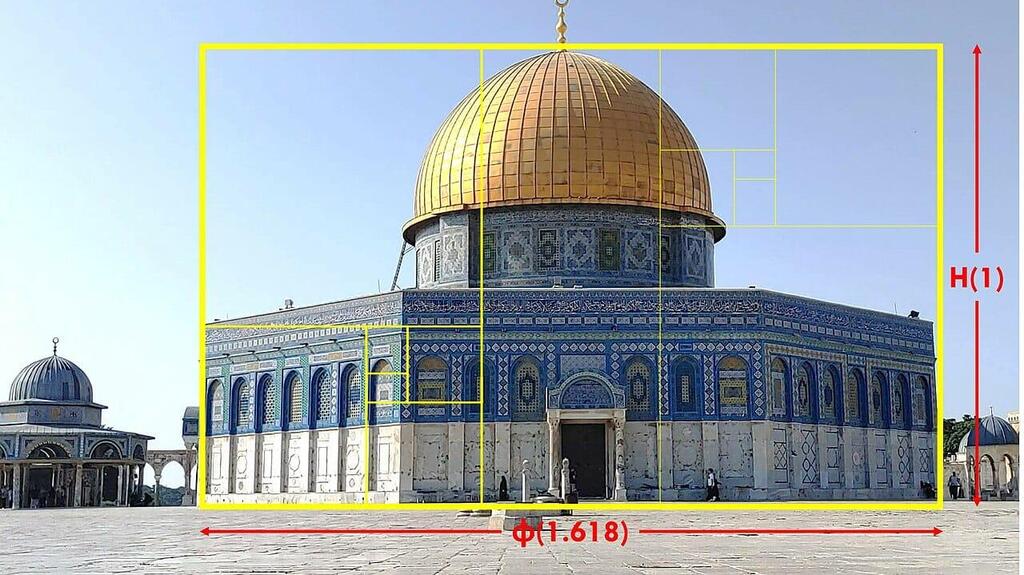The Dome of the Rock is the first monumental building built by the Muslim Caliphate, and over the years has become one of the most magnificent buildings in the Middle East. The structure, octagonal with a dome in the center, is built on the upper level of the Temple Mount in the Old City of Jerusalem. A new study looking at the structure of the Dome of the Rock reveals a surprising discovery, that it was built according to the dimensions of the "golden section theory," also known as the "golden ratio" - a mathematical ratio that represents many dimensions and sizes in nature and architecture first studied during the classical Greek period.
The question that remains a mystery is how the Muslims built the Dome of the Rock according to the golden ratio in the days when mathematics was not yet studied in Islam.
Dr. Dov Tamarkin has always been interested in the Dome of the Rock. As part of his doctoral thesis in history, he began to investigate the structure of the Dome of the Rock and discovered a phenomenon that no one had noticed before: The Dome of the Rock was built according to the "golden ratio," which creates an organic, balanced, and aesthetically pleasing composition..
"One of the things that has always fascinated me as a Jerusalemite is the Dome of the Rock. Every time I visited there, I was enveloped by a feeling of majesty, splendor and holiness. The aesthetics of the structure are amazing. Why this structure gives these feelings to the observer is a question that has occupied many researchers over the years, and is still being discussed to this day," Tamarkin explains.
4 View gallery


Measurements of the Dome of the Rock are compatible with the Golden Ratio
(Photo: Dr. Dov Tamarkin)
Tamarkin, a doctor of chemistry who changed careers and became a tour guide and historian, decided to investigate the Dome of the Rock as part of his doctoral work at Tel Aviv University, and to understand why the structure leaves such an impression on the observer. He climbed the Temple Mount again and again, viewed and photographed the Dome of the Rock from different directions and distances, and using computer graphics discovered that the ratio between the width of the building and its height corresponds to the golden ratio (golden section theory).
The "golden ratio" is a mathematical ratio represented by the number 1.618 and denoted by the Greek letter Φ. This ratio was first discovered and described by one of Pythagoras' students, Euclid, about 2,300 years ago. It turns out that the golden ratio appears in many bodies in nature, including the dimensions of chemical molecules, through the structure of flowers, the dimensions of the human body, to the shape of galaxies in space.
The golden ratio is found in architectural structures from the time of ancient Greece to the present day. Luca Pacioli, an Italian mathematician from the Renaissance period, together with his student Leonardo da Vinci, dedicated a three-volume book to the golden ratio, which they called "The Divine Proportion."
Tamarkin says that he discovered that not only does the general outline of the Dome of the Rock structure correspond with the golden ratio, but so do many other dimensions, such as the ratio between the full height of the octagonal structure's wall and the height of the door jambs. He adds that from an overhead view it is possible to recognize that the dimensions of the building's roof correspond to the golden ratio and, to his great surprise, the golden ratio is also maintained inside the building.
"I realized that I had discovered a possible, innovative explanation for the question of what gives the Dome of the Rock the aesthetics and the feeling of majesty, splendor and holiness that every person who looks at it gets. What is surprising is that the Dome of the Rock structure is the first monumental structure that was built in the seventh century by the emerging Muslim Caliphate - that is, during the formative period of the formation of Islam and its establishment. In those days, mathematics was not yet known in Islam, and now the question arises as to how they built the structure and included the golden ratio in it," Tamarkin says.
4 View gallery


The Dome of the Rock structure is the first monumental structure that was built in the seventh century by the emerging Muslim Caliphate
(Photo: Leonard Jaber, Shutterstock)
Tamarkin is now trying to find an answer to this question, on a timeline of 1,000 years, from the formulation of the golden section theory by Euclid to the construction of the Dome of the Rock. Tamarkin's innovative research will be presented at Yad Yitzhak Ben-Zvi's seventh Jerusalem Days conference, which will be held on July 30. The conference will deal with different topics, periods and aspects of Jerusalem, and will present to the participants studies and discoveries of senior researchers on the subject of Jerusalem.
"It is possible that the builders of the Dome of the Rock were aided by Byzantine knowledge, which was in the hands of the inhabitants of the country at that time. It should be noted that in the 1990s, the remains of an octagonal church from the Fifth Century AD were discovered in southern Jerusalem, which was identified as the Church of the Kathisma. Archaeologist Rina Avner, who managed the excavations of the church, pointed out a similarity between its construction and the Dome of the Rock, which was built in the Seventh Century. At the same time, there is no mention in the study of the existence of the Golden Ratio in the Kathisma church," explains Tamarkin.



